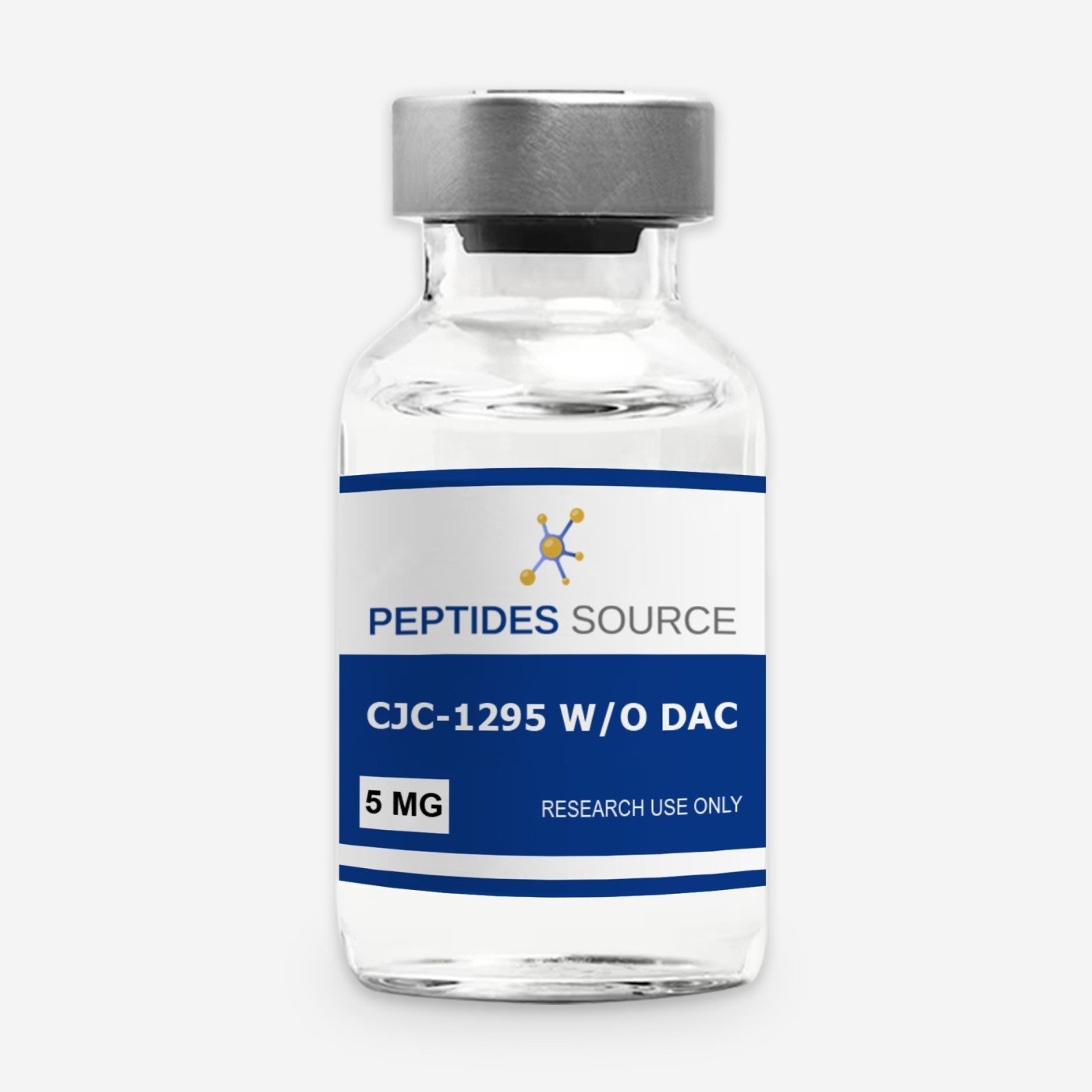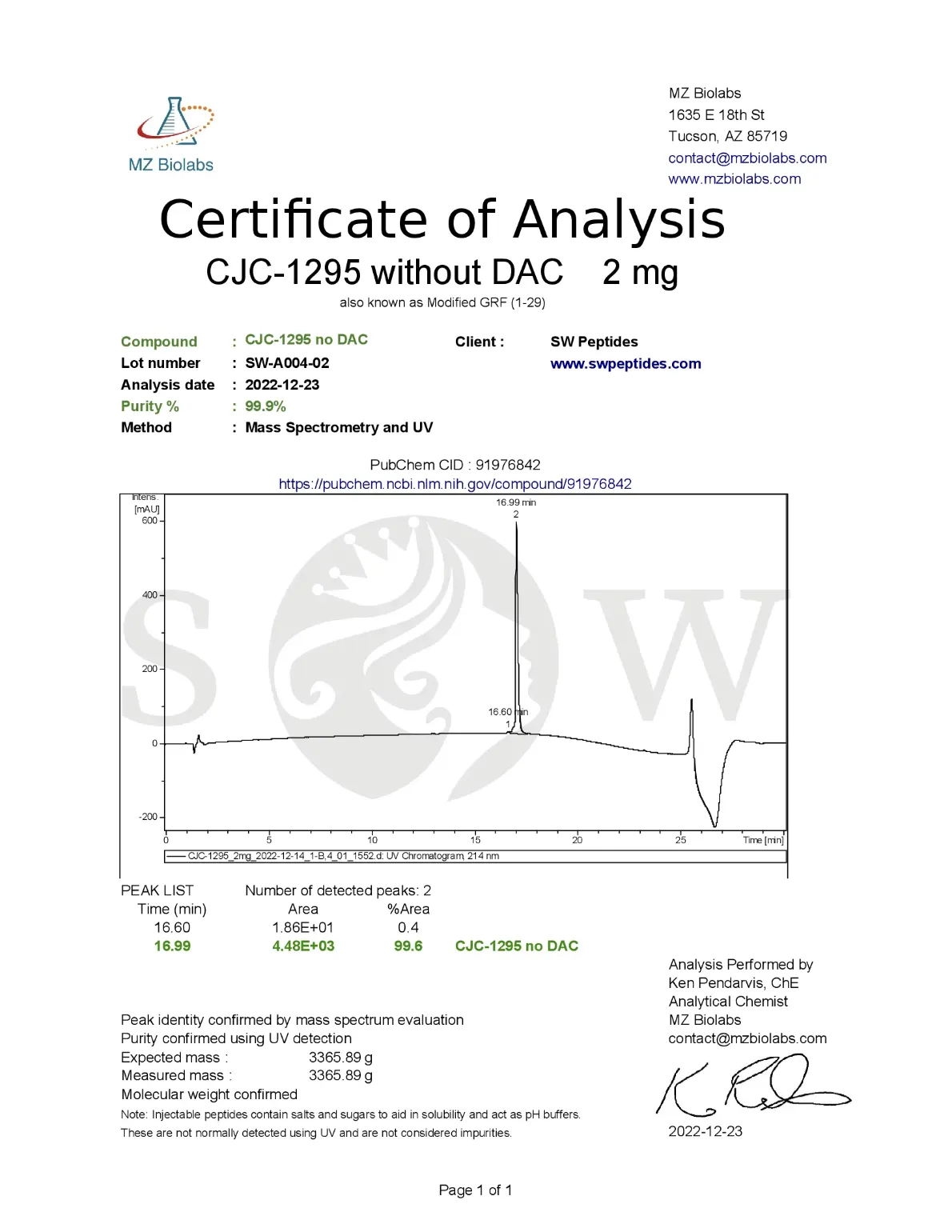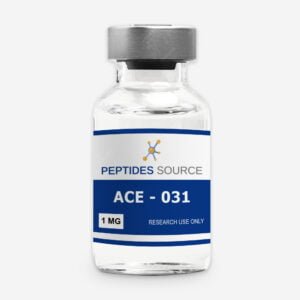CJC-1295 Without DAC 5mg
$27.50 - $40.00
You save
- Physical profile: Lyophilized powder
- This product is sold as a research chemical and not for human or animal consumption. For laboratory use by qualified professionals.
Availability: Ships today if ordered and paid by 12 PM EST. (Except Saturdays & Sundays)
Product Usage
This PRODUCT IS INTENDED AS A RESEARCH CHEMICAL ONLY. This designation allows the use of research chemicals strictly for in vitro testing and laboratory experimentation only. All product information available on this website is for educational purposes only. Bodily introduction of any kind into humans or animals is strictly forbidden by law. This product should only be handled by licensed, qualified professionals. This product is not a drug, food, or cosmetic and may not be misbranded, misused or mislabled as a drug, food or cosmetic.
Introduction
CJC-1295 without DAC, also known as Mod GRF 1-29, is a synthetic peptide designed to mimic the natural growth hormone-releasing hormone (GHRH). It comprises the first 29 amino acids of the GHRH molecule, which are critical for stimulating the anterior pituitary to release growth hormone (GH). This shorter, modified peptide is engineered to improve stability and efficacy over the naturally occurring hormone fragment. Specifically, it includes four amino acid substitutions to enhance its half-life and resistance to enzymatic degradation and this allows it to remain active in the body long enough to exert a meaningful biological effect, while still clearing quickly enough to mimic natural GH pulses.
The “without DAC” distinction refers to the absence of a Drug Affinity Complex, which in the original version of CJC-1295 serves to bind the peptide to albumin in the blood, thereby dramatically extending its half-life to several days. By contrast, CJC-1295 without DAC has a half-life of around 30 minutes, promoting a more physiological, pulse-like release of GH. This pulse is preferred in many cases, as it better aligns with how the human body naturally produces and utilizes growth hormone throughout the day.
The primary function of Mod GRF 1-29 is to enhance the body’s natural secretion of GH rather than introduce exogenous growth hormone. This makes it appealing for those studying age-related GH decline, metabolic issues, recovery enhancement, and muscle development in research contexts. It does not directly stimulate growth hormone secretion in a continuous or excessive way but rather facilitates the body’s own episodic release.
Researchers often study this peptide in combination with GH secretagogues like Ipamorelin, which help potentiate the GH release effect while minimizing side effects. Since Mod GRF 1-29 is used to stimulate short bursts of GH, it is typically administered multiple times a day via subcutaneous injection to simulate the body’s natural rhythms.
Although not approved for therapeutic use outside research, the physiological rationale behind Mod GRF 1-29 continues to draw attention for its potential in supporting regeneration, recovery, and metabolic balance, particularly in aging-related studies.
Overview
CJC-1295 without DAC, commonly referred to in research as Mod GRF 1-29, represents a modern and refined approach to growth hormone stimulation through indirect means. It is categorized as a GHRH analog and functions by prompting the pituitary gland to secrete growth hormone in response to stimulation, rather than supplying GH directly. This makes it fundamentally different from synthetic GH therapies, which can potentially disrupt the endocrine feedback loop.
One of the key features of CJC-1295 without DAC is its short half-life of approximately 30 minutes. This rapid clearance is seen as a benefit rather than a limitation, it allows GH to be secreted in quick bursts that resemble the body’s natural secretion cycles. This pulsatile secretion is considered safer and more physiologically appropriate, reducing the risks associated with long-term elevated GH levels, such as acromegaly or insulin resistance.
Mod GRF 1-29 is particularly notable for its structural improvements over the original GHRH(1-29). The four amino acid substitutions incorporated into its structure were deliberately chosen to enhance its stability and resistance to enzymatic breakdown, thereby improving its pharmacokinetics and biological activity. These substitutions help ensure that the peptide can perform effectively in vivo long enough to activate the pituitary gland and trigger a significant GH release.
In research settings, this peptide is often administered alongside other compounds—most commonly Ipamorelin, a selective GH secretagogue. The combination is synergistic: while Mod GRF 1-29 stimulates the pituitary to release GH, Ipamorelin ensures that this release is robust without causing a significant increase in other hormones such as prolactin or cortisol. This tandem approach offers a more balanced and targeted stimulation of GH production.
A notable benefit of using Mod GRF 1-29 is its ability to avoid disrupting the body’s natural GH feedback loop. Since it stimulates GH through natural mechanisms, it allows downstream processes such as IGF-1 production to occur more rhythmically. This has implications for improved sleep quality, faster recovery, lean muscle retention, and better fat metabolism, areas of interest in both anti-aging research and sports science.
Typical research protocols involve multiple daily injections due to the peptide’s short duration of action. This mimics the body’s ultradian rhythm of GH pulses throughout the day and night. Because of its transient nature, careful timing and consistent administration are essential for observing meaningful outcomes in studies.
Importantly, Mod GRF 1-29 has not been approved by regulatory authorities for human or veterinary medical use. All studies and uses are limited to research settings. However, its popularity in scientific research continues to grow due to its safer profile compared to longer-acting analogs and synthetic GH, and its potential to yield insights into endocrine function, aging, and tissue regeneration.
To summarize, CJC-1295 without DAC offers a short-acting, high-fidelity mimicry of natural GH secretion, making it a valuable tool for researchers exploring growth hormone pathways. Its rapid clearance, flexibility in dosing, and synergistic use with peptides like Ipamorelin make it a cornerstone in growth hormone-related experimental studies. Researchers are especially interested in how this peptide may aid in understanding GH dynamics in metabolic health, physical recovery, and aging biology.
How it works?
CJC-1295 without DAC, also known as Mod GRF 1-29, functions as an analog of Growth Hormone-Releasing Hormone (GHRH). Its primary mechanism of action involves stimulating the anterior pituitary gland to release endogenous growth hormone (GH) in a natural, pulsatile manner.
Following is a step-by-step breakdown of how it works:
1. Binding to GHRH Receptors
CJC-1295 without DAC mimics the biological activity of the natural GHRH peptide by binding to GHRH receptors on somatotroph cells located in the anterior pituitary gland. These are the same receptors that the body’s own GHRH uses to stimulate GH release.
2. Stimulation of Growth Hormone Release
Upon binding, CJC-1295 activates intracellular signaling pathways, mainly involving adenylate cyclase and cyclic AMP (cAMP). This cascade ultimately triggers the synthesis and secretion of growth hormone into the bloodstream. Unlike synthetic GH injections, CJC-1295 doesn’t supply GH directly—it encourages your body to produce and release its own GH.
3. Pulse-Like Secretion
Because CJC-1295 without DAC has a short half-life (~30 minutes), it induces a brief but potent spike in GH release. This pulse-like behavior is important because:
- It mimics the body’s natural GH rhythm (which occurs mainly at night or during exercise).
- It avoids prolonged GH elevation, which could otherwise desensitize GH receptors or lead to side effects.
4. Downstream Effects via IGF-1
The GH released into circulation has numerous anabolic and metabolic effects, either directly or by stimulating the liver and other tissues to produce Insulin-like Growth Factor 1 (IGF-1). IGF-1 is responsible for many of the longer-term effects of GH, such as:
- Increased protein synthesis (muscle growth)
- Enhanced lipolysis (fat burning)
- Improved tissue repair
- Better skin and bone health
- Support of immune and cognitive function
5. Natural Feedback Regulation
Since CJC-1295 stimulates GH through the hypothalamic-pituitary axis, it preserves the body’s feedback mechanisms. Elevated levels of GH and IGF-1 will eventually signal the hypothalamus and pituitary to reduce further GH release, preventing excess or continuous stimulation—unlike exogenous GH use, which bypasses these feedback loops and can lead to suppression.
Structure
Amino Acid Sequence
Tyr-D-Ala-Asp-Ala-Ile-Phe-Thr-Gln-Ser-Tyr-Arg-Lys-Val-Leu-Gly-Gln-Leu-Ser-Ala-Arg-Lys-Leu-Leu-Gln-Asp-Ile-Met-Ser-Arg-Gln (29 amino acids)
This sequence includes modifications to improve stability, particularly at positions 2 (D-Ala), 8 (Gln), 15 (Ala), and 27 (Leu), which make it more resistant to enzymatic degradation.
Molecular Weight; 3367.9 g/mol (approximate)
Molecular Formula; C₁₅₂H₂₅₂N₄₄O₄₂
PubChem CID ; 91976842
Synonym; Mod GRF 1-29, Modified Growth Hormone-Releasing Factor (1-29), CJC-1295 No DAC, GRF (1-29) analog, Tetrasubstituted GRF (1-29), GHRH(1-29) amide (modified)
Research
Role in Stimulation of Growth Hormone Release
CJC-1259 without DAC, also referred to as Modified Growth Hormone-Releasing Factor (1-29) or Mod GRF (1-29), is a synthetic analog of the endogenous growth hormone-releasing hormone (GHRH). It was engineered to preserve the essential bioactive region of GHRH while improving the peptide’s stability and efficacy compared to the native hormone. Unlike its long-acting counterpart CJC-1295 with Drug Affinity Complex (DAC), CJC-1259 without DAC is designed to have a short half-life, producing a quick and natural pulse of growth hormone (GH) that mimics physiological secretion patterns.
The main role of CJC-1259 without DAC is to stimulate the pituitary gland to release GH via direct interaction with GHRH receptors. These receptors are located on somatotropic cells in the anterior pituitary, and their activation leads to the intracellular signaling cascade involving cyclic adenosine monophosphate (cAMP) and protein kinase A (PKA), which in turn stimulates GH synthesis and release (1). The short-acting nature of this peptide is particularly important because GH secretion in humans is naturally pulsatile, and prolonged or continuous stimulation—as observed with long-acting GH analogs—may lead to receptor desensitization and negative feedback inhibition (2).
When administered, CJC-1259 without DAC rapidly binds to the GHRH receptor, resulting in a sharp but brief increase in circulating GH levels within minutes. Peak GH concentrations are typically observed within 15 to 30 minutes, followed by a return to baseline within 1 to 2 hours (3). This profile is advantageous in both research and therapeutic contexts where controlled stimulation of GH is desired. It avoids the complications associated with prolonged exposure to elevated GH or insulin-like growth factor-1 (IGF-1), such as acromegaly, insulin resistance, or fluid retention.
Furthermore, studies have demonstrated that combining CJC-1259 without DAC with ghrelin mimetics such as Ipamorelin or GHRP-6 amplifies the GH pulse due to synergistic activity on separate receptor pathways. While CJC-1259 stimulates the GHRH receptor, ghrelin analogs target the growth hormone secretagogue receptor (GHS-R1a), resulting in greater amplitude of GH release (4). This combination approach is often used in experimental and off-label peptide therapy settings.
In summary, CJC-1259 without DAC plays a vital role in modulating growth hormone levels by initiating a biologically consistent GH pulse. Its ability to trigger a natural-like, transient GH surge makes it valuable for GH optimization protocols, research on endocrine function, and potentially for therapeutic purposes in conditions involving GH deficiency or muscle wasting. The short-acting property, in contrast to long-acting GH secretagogues, offers greater flexibility and control in clinical and investigational applications.
Role in Promotion of Muscle Growth and Fat Loss
CJC-1259 without DAC (Mod GRF 1-29) contributes significantly to muscle growth and fat loss by stimulating the endogenous release of growth hormone (GH), which in turn increases levels of insulin-like growth factor-1 (IGF-1). These two anabolic hormones play essential roles in regulating muscle protein synthesis, lipolysis, and body composition.
GH promotes lipolysis by activating hormone-sensitive lipase in adipocytes, resulting in the breakdown of triglycerides into free fatty acids and glycerol (5). This mechanism increases the body’s reliance on fat as an energy source, particularly during fasting or low-insulin states. Simultaneously, GH and IGF-1 enhance muscle hypertrophy and regeneration by stimulating satellite cell proliferation, myoblast fusion, and protein synthesis, making CJC-1259 without DAC a favorable peptide for muscle recovery and development (6).
Due to its short half-life, CJC-1259 without DAC induces a pulsatile GH response, which is more physiologically aligned with the body’s natural rhythm. This pulsed release may help preserve insulin sensitivity, unlike constant GH exposure, which is known to promote insulin resistance (7). In practice, CJC-1259 is often paired with ghrelin mimetics such as Ipamorelin to enhance the amplitude of GH peaks, further accelerating fat oxidation and lean muscle accrual.Although most data are derived from animal studies and off-label use in humans, preliminary findings suggest that CJC-1259 without DAC offers a non-synthetic GH alternative to improve body composition, with fewer side effects than exogenous GH administration (8)
Role in Anti-Aging and Rejuvenation Therapies
CJC-1259 without DAC has gained attention in anti-aging and regenerative medicine due to its ability to stimulate pulsatile growth hormone (GH) release, thereby increasing insulin-like growth factor-1 (IGF-1) levels. Both GH and IGF-1 are known to decline with age, contributing to reduced lean body mass, skin elasticity, bone density, and metabolic efficiency (9). By mimicking the natural GH secretion rhythm, CJC-1259 without DAC offers a physiological method to restore youthful hormonal patterns.
Unlike exogenous GH therapy, which is associated with risks such as insulin resistance and fluid retention, CJC-1259’s short-acting nature limits systemic overexposure, reducing potential side effects (10). Clinical observations suggest improvements in sleep quality, skin texture, energy levels, and body composition in aging individuals receiving peptide therapies involving CJC-1259 (11). Additionally, its role in enhancing protein synthesis and promoting fat oxidation contributes to functional longevity and tissue repair.
Although long-term human studies are limited, early evidence supports the inclusion of CJC-1259 without DAC in peptide-based anti-aging protocols, especially when used alongside synergistic secretagogues like Ipamorelin.
Role as an Adjunct in Peptide Therapy Research
CJC-1259 without DAC is frequently used in peptide therapy research as a short-acting model for growth hormone secretagogues. It allows researchers to evaluate pulsatile GH release, receptor sensitivity, and synergistic effects when combined with ghrelin analogs like Ipamorelin (12). Its predictable pharmacokinetics make it ideal for comparing to long-acting analogs such as CJC-1295 with DAC (13). This peptide also serves as a valuable tool in studying endocrine feedback mechanisms and optimizing dosing strategies in both clinical and experimental settings (14).
References
- Mayo KE, Godfrey PA, Suhr ST, Kulik DJ, Rahal JO. Growth hormone-releasing hormone: synthesis and signaling. Recent Prog Horm Res. 1995;50:35–73.
- Culler MD, Bluher M, Hofland LJ. Endocrine regulation of GH secretion and feedback mechanisms. Best Pract Res Clin Endocrinol Metab. 2016;30(6):683–695.
- Teichman SL, Neale A, Lawrence B, Heffernan M, Culler MD. Prolonged stimulation of GH and IGF-1 secretion by CJC-1295, a long-acting analog of GHRH, in healthy adults. Eur J Endocrinol. 2006;155(1):109–117.
- Schmid HA. Ghrelin and ghrelin receptor modulators: The emerging role in GH regulation. Growth Horm IGF Res. 2004;14(Suppl A):S91–S97.
- Møller N, Jørgensen JOL. Effects of growth hormone on glucose, lipid, and protein metabolism in human subjects. Endocr Rev. 2009;30(2):152–177.
- Velloso CP. Regulation of muscle mass by growth hormone and IGF-1. Br J Pharmacol. 2008;154(3):557–568.
- Cornford AS, Barkan AL, Horowitz JF. Rapid suppression of lipolysis by GH-induced insulin resistance. Diabetes. 2011;60(2):325–332.
- Walker RF, Zorc JJ, Ceddia MA. Effects of growth hormone-releasing hormone analogs on skeletal muscle and adipose tissue in aging rats. Mech Ageing Dev. 2001;122(5):455–468.
- Rudman D, Feller AG, Nagraj HS, et al. Effects of human growth hormone in men over 60 years old. N Engl J Med. 1990;323(1):1–6.
- Liu H, Bravata DM, Olkin I, et al. Systematic review: the safety and efficacy of growth hormone in the healthy elderly. Ann Intern Med. 2007;146(2):104–115.
- Molitch ME. Growth hormone therapy in adults: Physiologic and clinical considerations. J Clin Endocrinol Metab. 2013;98(6):2187–2193.
- Schmid HA. Ghrelin receptor ligands: tools for investigating GH release. Growth Horm IGF Res. 2004;14(Suppl A):S91–S97.
- Teichman SL et al. Prolonged GH stimulation by CJC-1295 in humans. Eur J Endocrinol. 2006;155(1):109–117.
- Culler MD. Investigational uses of GHRH analogs. Trends Endocrinol Metab. 2003;14(6):259–263.





